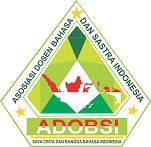Konteks, Tema, Skemata, Memori, dan Pikiran : Mendukung Pembelajaran Bahasa Sebagai Penghela Ilmu Pengetahuan
DOI:
https://doi.org/10.21776/ub.hastawiyata.2018.001.02.02Keywords:
Konteks, Tema, Skemata, Memori, Pikiran, Pembelajaran Integratif, Disiplin Ilmu BahasaAbstract
An integrative approach leads to a new point of view in interpreting learning process. This approach allows students to simultaneously mastering multiple disciplines in a an or a single learning task; linking it in the same context and theme. According to the existence of academic texts, the context supports the existence of relationships between several scientific contexts; including the content and scope of discussion related to certain fields of science. With the theme, each curricular content is able to connect in a match network to develop interdisciplinary units. This allows multiple teachers in different disciplines to join to build shared learning with integrated learning objectives; in one theme. In turn, the integrative concept allows students to think and store their learning thoughts well, connected, continuous, deep, and stronger (persisting and not easily forgotten). This means that what the student has learned is assumed to be more durable in his mind's memory. This assumption is based on the development of schemata, the storage of knowledge information in memory, and the management of the mind when integrative learning is performed.These concept can be realized in language learning. Language disciplines have unique and special functions as a carrier of knowledge and as inter-disciplinary advocates. The usefulness of these two functions is great for the functional progress of the Language disciplines. The study of language as a carrier of knowledge can be interpreted that the science of language into a vehicle that brings science to other sciences.
References
Alwi, Hasan, Soenjono, D., Hans L., Anton M. (1994). Tata Bahasa Baku Bahasa Indonesia. Jakarta: Depdikbud
Axelrod, R. (1973). Schema Theory : An Information Processing Model of Perception and Cognition. Amerika: APSA (American Political Science Association) berkolaborasi dengan JSTOR untuk digitalisasi data dalam www. JSTOR.org.
Barnes, M. B., Spector, B. S., & Shaw, T. (1989). How science is learned by adolescents and young adults. Kendall/Hunt Publishing Company.
Bartlett, F. C. (1932). Remembering. London: Cambridge University Press.
Beane, J. A. (1995). Curriculum Integration and the Discipline of Knowledge. Vol.76, No. 8. Phi Delta Kappa International Vol. 6 No.8 , 616-622.
Brown, G. dan Yule, G.(1983). Discourse Analysis.
Carrell P. dkk. (ed). (1992). Interactive Approach to Second Language Reading. Cambridge: Gambridge University Press.
Chaer, A. (2003). Psikolinguistik: kajian teoretik. Rineka Cipta.
Clark, H. H., & Clark, E. V. (1977). Psychology and language: An introduction to psycholinguistics. New York: Harcourt Brace Jovanovich.
Darjowodjojo, S. (2012). Psikolinguistik. Jakarta: Yayasan Obor Indonesia.
Halliday, M. A. (1994). Bahasa, Konteks, dan Teks : Aspek-aspek Bahasa dalam Pandangan Semiotik Sosial. (R. Hasan, Trans.) Yogyakarta, Gajahmada University Press.
Halliday, M. A., & Hasan, R. (1989). Language, context, and text: Aspects of language in a social-semiotic perspective.
Helen K. & Arthur E. Johnson Foundation. (2004). Thinking Strategies for Leasners : A guide to PEBC’s professional development in reading, writing, mathematics, and information literacy. Denver : Public Education & Business Coalition (PEBC).
Ivanitskaya, L., Clark, D., Montgomery, G., & Primeau, R. (2002). Interdisciplinary learning: Process and outcomes. Innovative Higher Education, 27(2), 95–111.
Martin, J. R. (1992). English Text: System and Structure. Philadelpia /Amsterdam: John Benjamins.
McDonald, J., & Czerniak, C. (1994). Developing interdisciplinary units: Strategies and examples. School Science and Mathematics, 94(1), 5-10.
Mey, Jacob L. (1993). Pragmatics. An Introduction. Oxford: Blackwell.
Motta-Roth, D. (2010). Genre in a Changing World. The Role of Context in Academic Text Production and Writing Pedagogy (C. Bazerman, A. Bonini, & D. Figueiredo, Eds.) Fort Collins: WAC Clearinghouse; West Lafa.
Omaggio, A. (1986). Teaching Language in Context : Proficiency Oriented Instruction. Boston, MA: Heinle & Heinle Publishers.
Saragih, A. (2002). Bahasa dalam Konteks Sosial. Medan: Fakultas Bahasa dan Seni Universitas Medan.
Saragih, A. (2007). Fungsi Tekstual dalam Wacana : Panduan Menulis Rema dan Tema. Medan : Balai Bahasa Medan.
Sinar, Tengku Silvana. (2009). Teori dan Analisis Wacana 2: Pendekatan Linguistik Sistemik Fungsional. Jakarta: Perpustakaan Nasional.
Sumarlam. (2003). Teori dan Praktik Analisis Wacana. Surakarta: Pustaka Cakra.
Sutjaja, I. G. (2005). Linguistik, Bahasa Bali, dan Dunia Virtual. Pidato Ilmiah Pengukuhan Jabatan Guru Besar Tetap dalam Bidang Ilmu Bahasa, Fak Sastra, Universitas Udayana. Jimbaran: Universitas Udayana.
Vygotsky, L. S. (1986). Thought and language (rev. ed.).
Wiles, J. W., & Bondi, J. W. (1986). Making middle schools work. Publication Sales, Association for Supervision and Curriculum Development, 125 North West Street, Alexandria, VA 22314 (ASCD Stock Number: 611-86046).














